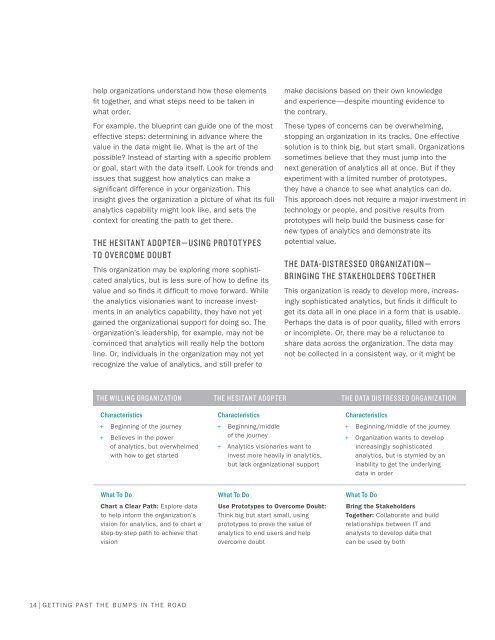Tips for Building a Data Science Capability
WH4vS
WH4vS
Create successful ePaper yourself
Turn your PDF publications into a flip-book with our unique Google optimized e-Paper software.
help organizations understand how those elements<br />
fit together, and what steps need to be taken in<br />
what order.<br />
For example, the blueprint can guide one of the most<br />
effective steps: determining in advance where the<br />
value in the data might lie. What is the art of the<br />
possible? Instead of starting with a specific problem<br />
or goal, start with the data itself. Look <strong>for</strong> trends and<br />
issues that suggest how analytics can make a<br />
significant difference in your organization. This<br />
insight gives the organization a picture of what its full<br />
analytics capability might look like, and sets the<br />
context <strong>for</strong> creating the path to get there.<br />
THE HESITANT ADOPTER—USING PROTOTYPES<br />
TO OVERCOME DOUBT<br />
This organization may be exploring more sophisticated<br />
analytics, but is less sure of how to define its<br />
value and so finds it difficult to move <strong>for</strong>ward. While<br />
the analytics visionaries want to increase investments<br />
in an analytics capability, they have not yet<br />
gained the organizational support <strong>for</strong> doing so. The<br />
organization’s leadership, <strong>for</strong> example, may not be<br />
convinced that analytics will really help the bottom<br />
line. Or, individuals in the organization may not yet<br />
recognize the value of analytics, and still prefer to<br />
make decisions based on their own knowledge<br />
and experience—despite mounting evidence to<br />
the contrary.<br />
These types of concerns can be overwhelming,<br />
stopping an organization in its tracks. One effective<br />
solution is to think big, but start small. Organizations<br />
sometimes believe that they must jump into the<br />
next generation of analytics all at once. But if they<br />
experiment with a limited number of prototypes,<br />
they have a chance to see what analytics can do.<br />
This approach does not require a major investment in<br />
technology or people, and positive results from<br />
prototypes will help build the business case <strong>for</strong><br />
new types of analytics and demonstrate its<br />
potential value.<br />
THE DATA-DISTRESSED ORGANIZATION—<br />
BRINGING THE STAKEHOLDERS TOGETHER<br />
This organization is ready to develop more, increasingly<br />
sophisticated analytics, but finds it difficult to<br />
get its data all in one place in a <strong>for</strong>m that is usable.<br />
Perhaps the data is of poor quality, filled with errors<br />
or incomplete. Or, there may be a reluctance to<br />
share data across the organization. The data may<br />
not be collected in a consistent way, or it might be<br />
THE WILLING ORGANIZATION THE HESITANT ADOPTER THE DATA DISTRESSED ORGANIZATION<br />
Characteristics<br />
+ + Beginning of the journey<br />
+ + Believes in the power<br />
of analytics, but overwhelmed<br />
with how to get started<br />
Characteristics<br />
+ + Beginning/middle<br />
of the journey<br />
+ + Analytics visionaries want to<br />
invest more heavily in analytics,<br />
but lack organizational support<br />
Characteristics<br />
+ + Beginning/middle of the journey<br />
+ + Organization wants to develop<br />
increasingly sophisticated<br />
analytics, but is stymied by an<br />
inability to get the underlying<br />
data in order<br />
What To Do<br />
Chart a Clear Path: Explore data<br />
to help in<strong>for</strong>m the organization’s<br />
vision <strong>for</strong> analytics, and to chart a<br />
step-by-step path to achieve that<br />
vision<br />
What To Do<br />
Use Prototypes to Overcome Doubt:<br />
Think big but start small, using<br />
prototypes to prove the value of<br />
analytics to end users and help<br />
overcome doubt<br />
What To Do<br />
Bring the Stakeholders<br />
Together: Collaborate and build<br />
relationships between IT and<br />
analysts to develop data that<br />
can be used by both<br />
14 | GETTING PAST THE BUMPS IN THE ROAD


